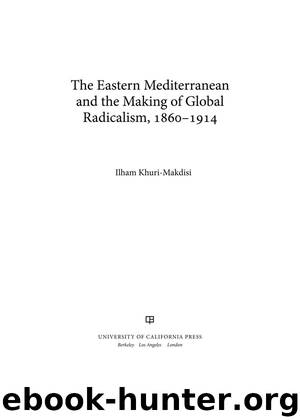The Eastern Mediterranean and the Making of Global Radicalism, 1860-1914 by Khuri-Makdisi Ilham;

Author:Khuri-Makdisi, Ilham;
Language: eng
Format: epub
Publisher: University of California Press
Published: 2012-01-22T16:00:00+00:00
Fluid and Porous Categories
In the late nineteenth century and early twentieth the majority of workers in Egypt and the Ottoman Empire were crafts workers and artisans concentrated in small units of production, mostly in homes and workshops and small factories with ten employees or fewer.22 Their number seems to have been on the rise, in both relative and absolute terms.23 In fact only a very small percentage of the workforce was involved in factory work in the Ottoman Empire and Egypt, where industrial production before 1914 represented a tiny proportion of the national economy.24 By one estimate, of a total Ottoman labor force of 9.5 million in 1914, 280,000 workers were employed in manufacturing, and another 200,000 were equally divided between construction and transportation.25 In the case of Egypt, the census of 1907 reported almost 380,000 workers engaged in industry out of a population of more than eleven million; this figure included 45,000 hand loom weavers and 11,000 railway workers.26
How valid is this dichotomy between these various labor (and social) categories, namely, artisans, factory workers, construction workers, industrial workers, and even agricultural workers? We know that throughout the eighteenth and nineteenth centuries there were overlaps between craftsmen, manufacturers, and factory workers in Cairo, Damascus, and Mount Lebanon. It was not uncommon for artisans “[to supplement] their income through work which was in many ways similar to their own: carpentry, weaving, or spinning. The same may be said for other manufactories in branches such as textiles, glassworks, or sugar refining.”27 Factories throughout the nineteenth century employed artisans and members of construction guilds, and Damascene journeymen weavers were increasingly being transformed into factory workers in the mid- and late nineteenth century.28 There was no rupture between old ways of production and modern mechanized ways, but rather a progressive adaptation of the old into the new and the coexistence of these two forms for long periods of time.29 Factory work in textiles, for instance, was often similar to work that had been taking place for decades in small workshops, and weavers or other artisans involved in textile making or clothes manufacturing were the obvious contenders for such factory jobs. Factories often employed “aggregates of artisans organized under one roof. . . . The sheer variety of trades present in the factories is striking.”30 When artisans in a collapsing sector went in search of a new profession they were very likely to end up working in factories and on construction sites, doing jobs that did not require specific skills. Rather than completely severing ties with their guild, previous profession, or artisanal customs and culture, artisans-turned-workers most likely transposed many of those ties to their new sites of employment. The maintaining of ties between guilds and small industry was confirmed by Vallet in 1911: “Qu’en un mot, les corporations puissent être considérées comme abolies de fait, c’est possible, mais . . . il subsiste des ‘corporations’ de fait entre les artisans de la petite industrie. Toute la partie du Caire qui s’étend au pied des
Download
This site does not store any files on its server. We only index and link to content provided by other sites. Please contact the content providers to delete copyright contents if any and email us, we'll remove relevant links or contents immediately.
| Anarchism | Communism & Socialism |
| Conservatism & Liberalism | Democracy |
| Fascism | Libertarianism |
| Nationalism | Radicalism |
| Utopian |
The Secret History by Donna Tartt(18147)
The Social Justice Warrior Handbook by Lisa De Pasquale(11950)
Thirteen Reasons Why by Jay Asher(8445)
This Is How You Lose Her by Junot Diaz(6430)
Weapons of Math Destruction by Cathy O'Neil(5824)
Zero to One by Peter Thiel(5487)
Beartown by Fredrik Backman(5348)
The Myth of the Strong Leader by Archie Brown(5236)
The Fire Next Time by James Baldwin(5015)
How Democracies Die by Steven Levitsky & Daniel Ziblatt(4950)
Promise Me, Dad by Joe Biden(4907)
Stone's Rules by Roger Stone(4852)
100 Deadly Skills by Clint Emerson(4683)
A Higher Loyalty: Truth, Lies, and Leadership by James Comey(4546)
Rise and Kill First by Ronen Bergman(4542)
Secrecy World by Jake Bernstein(4387)
The David Icke Guide to the Global Conspiracy (and how to end it) by David Icke(4376)
The Farm by Tom Rob Smith(4320)
The Doomsday Machine by Daniel Ellsberg(4241)
